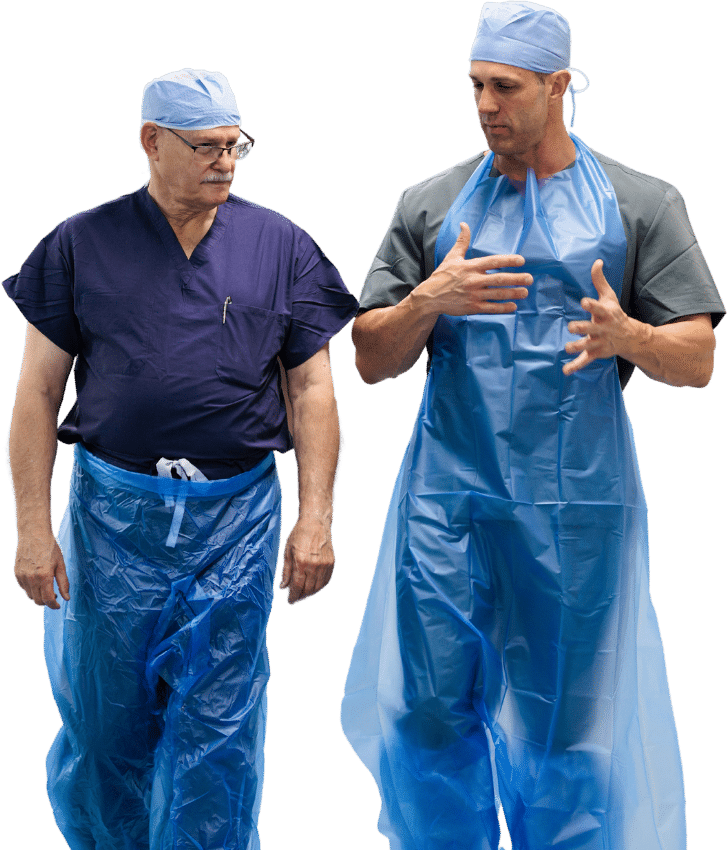It’s time to tackle some misconceptions about the cost of single-use PPE. When you think of personal protective equipment, what comes to mind? Probably a flimsy surgical apron that you wear once and throw away. With the rise of reusable PPE, many healthcare workers assume single-use surgical PPE is unreliable, wasteful, and expensive in the long run.
The truth is, with better quality disposable medical apparel and surgical PPE, you can strike the right balance between cost and protection.
When people talk about the cost of single-use PPE, like disposable medical protective clothing, there’s often a lot of confusion. Many believe these items are always cheap because they’re disposable. Others think healthcare facilities waste money on these plastics in healthcare. However, these views don’t show the full picture.
In reality, the costs depend on several factors, including supply chain issues and patient safety needs. High demand and supply chain disruptions can drive up prices. Investing in quality PPE protects healthcare workers and patients, which can save money in the long run.
Let’s take a closer look at three common misconceptions about the cost of single-use PPE and see why they might not hold up. Understanding the truth can help you make better decisions for your healthcare facility, ensuring safety and cost-efficiency.
Reusable PPE Isn’t More Affordable in the Long Run
Here’s one of the biggest misconceptions about the cost of single-use PPE. Many people think that reusable PPE is cheaper for hospitals. This assumption isn’t always true. Reusable PPE poses financial risks due to possible cross-contamination. If not cleaned properly, these items might spread healthcare-associated infections (HAIs), which can lead to increased patient care costs and legal liabilities. Single-use items significantly reduce these risks.
HAIs harm patients and strain hospital finances. Treating infections often involves extra medication, longer hospital stays, and additional procedures. This adds up quickly, making reusable PPE seem costly in comparison. A focus on patient safety can save money in the long run – especially since the economic burden of HAIs has been estimated in the $20-40 billion dollar range.
In fact, according to JAMA Internal Medicine, the five most common HAIs cost $9.8 billion last year.
Single-use disposable medical protective clothing offers a safer alternative. It’s used once and then discarded, minimizing infection risks for patients and staff, too.
First, when reusable PPE fails, isn’t properly sanitized, or is used incorrectly, your workers get sick or injured. This can lead to workers’ compensation claims, sickouts, and lost wages. When healthcare workers can’t work, it creates shortages.
Ultimately, while reusable items may initially look cost-effective, the hidden risks may prove otherwise. Hospitals need to consider these factors when deciding which PPE to use.
Explore the detailed cost-benefit analysis for premium PPE vs. other solutions here.
Single-Use Isn’t the Same as Single-Patient
Another one of the misconceptions about the cost of single-use PPE is right there in the name: “single-use.”
In the world of healthcare, not all “single-use” items are created equal. For example, premium PPE products like Sloan Medical’s ezGLIDE patient transfer sheets are actually single-patient, not single-use. This means one transfer sheet can stay with a patient for the duration of their hospital stay. It’s used for multiple transfers without the waste of switching sheets or finding another patient transfer board each time.
Let’s compare the use of these single-patient disposable transfer sheets to reusable patient transfer boards:
- Hygiene: Single-patient sheets minimize infection risk since the same sheet remains with the patient.
- Convenience: No frequent cleaning is required, unlike reusable boards.
- Cost-Effective: Reduces the need for constant sanitizing, saving on labor and cleaning materials.
- Patient Comfort: Designed for softer, smoother transfers, leading to a better patient experience.
So, when you hear “single-use,” consider that the PPE in question might be better described as “single-patient” and what that truly means for your hospital, patients, healthcare workers, and your bottom line.
All Single-Use PPE Isn’t Created Equally
Not all single-use PPE is created equally. Premium PPE is made from higher-quality materials. This means it doesn’t rip or tear easily. So, hospitals actually end up using fewer units. Using fewer units creates less waste and provides better protection for staff and patients. Let’s take a closer look.
Premium disposable medical protective clothing may be pricier upfront, but regular PPE can end up being more expensive. Rips and tears mean constant replacement, so the costs add up quickly when you compare the cost case by case.
Protective wear that lasts longer keeps healthcare workers safer. It also helps keep patient safety at the forefront. Durable PPE means stronger protection against infections. Plus, healthcare facilities help the environment too.
Investing in well-made surgical PPE can lead to cost savings and better safety. Your surgical PPE clothing should be at least 2 ml thick with heat-sealed seams to keep blood and bodily fluids out. Make sure the PPE you stock has been tested against and meets the ASTM F1671 standards for blood and fluid impermeability.
Scrubs Don’t Provide Enough Protection to Skip Disposable Medical Protective Clothing
It’s another one of the common misconceptions about the cost of single-use PPE that medical scrubs alone offer enough protection for healthcare workers, so disposable medical protective gear isn’t necessary.
Here’s the truth: scrubs just aren’t designed to shield against blood-borne and fluid-borne illnesses, and scrubs alone won’t help keep blood and bodily fluids out of your shoes during a wet surgery.
Healthcare workers should always use additional layers of disposable medical protective clothing for better safety.
Here’s a list of items that enhance protection:
- Aprons: Shield the torso against splashes.
- Shoe Covers: Keep shoes free from contamination.
- Leggings: Protect the legs and prevent contamination from spreading.
- Jumpsuits: Offer full-body coverage to stop fluid transfer.
Some may consider these items unnecessary, but they do play a critical role in your facility’s infection control procedures. They protect workers and help maintain patient safety by reducing contamination risks.
Using disposable medical protective clothing is essential, even if some think it’s excessive. Protecting scrubs and shoes prevents damage and ensures safety against harmful exposures. Proper use of PPE is a small price to pay for increased safety and peace of mind.
Get the Facts: Use Our Comparison Guides
As you’re evaluating the right PPE options for your healthcare facility or surgical center, you have a lot of options. You may be comparing reusable supplies like patient transfer boards against disposable supplies like patient transfer sheets. You might also be comparing your washable medical protective clothing, like scrubs, to disposable options like aprons, jumpsuits, and shoe covers.
There’s a lot of data to sort through. That’s why we created two quick and easy comparison guides to help you weigh the pros & cons of your options!
Compare your patient transfer options using this comparison guide for patient transfer.
Then, take a look at the dos & don’ts of PPE that will protect your staff from dangerous pathogens and squishy shoes using this PPE comparison guide.
Try the PPE Developed by Surgeons for Surgeons
PPE and medical protective clothing will continue to advance as the medical community heads into the future together. Sloan Medical remains committed to researching and developing new and better PPE for surgeons and healthcare staff, using your feedback and experiences.
Founded by surgeons, we are dedicated to setting a higher bar for surgical safety and patient experience. We take pride in producing truly impervious and slip-resistant ISO medical-grade covers tested to provide the highest quality protection against fluids and contaminants.
Sloan Medical is confident that if you try our products, you’ll never go back. So, before you go, claim your free STA-DRI and ezGLIDE samples and see the difference for yourself.





